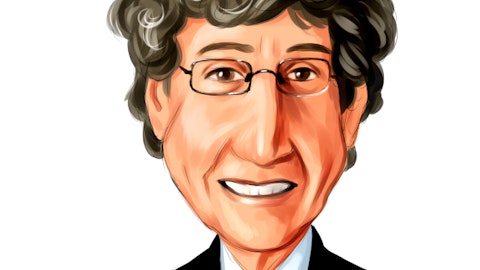Metropolitan Bank Holding Corp. (NYSE:MCB) Q3 2023 Earnings Call Transcript October 20, 2023
Operator: Welcome to Metropolitan Commercial Bank’s Third Quarter 2023 Earnings Call. Hosting the call today from Metropolitan Commercial Bank are Mark DeFazio, President and Chief Executive Officer; and Greg Sigrist, Executive Vice President and Chief Financial Officer. Today’s call is being recorded. [Operator Instructions] During today’s presentation, reference will be made to the company’s earnings release and investor presentation, copies of which are available at ncbankny.com. Today’s presentation may include forward-looking statements that are subject to risks and uncertainties that may cause actual results to differ materially. Please refer to the company’s notices regarding forward-looking statements and non-GAAP measures that appear in the earnings release. It is now my pleasure to turn the floor over to Mark DeFazio, President and Chief Executive Officer. You may begin.
Mark DeFazio: Thank you, Shelby, and good morning, and thank you all for joining our third quarter earnings call. I will be brief today because I’d like to leave more time for Q&A. . To get started, I am pleased with MCB’s third quarter and year-to-date results. To say the last 9 months have been challenging is an understatement. However, as you can see, MCB has been able to navigate through these challenging times, primarily because we were as prepared as we can be for them. Along with our ability to grow alongside of these challenges, Year-to-date, we have experienced reasonable balance sheet growth funded by new core deposits while maintaining our underwriting and pricing disciplines. All deposit verticals contributed to our growth in liquidity as well as early contributions from our latest initiatives in 1031, title and EV 5 lines.

A professional banker shaking hands with an entrepreneur in a boardroom setting. Editorial photo for a financial news article. 8k. –ar 16:9
Excess liquidity this quarter also allowed us to pay down our Federal Home Loan Bank borrowings, which were used specifically to off-ramp our previous on-balance sheet crypto deposits. We are confident we will see further reductions of these borrowings over the coming quarters. We are also confident that each of our deposit verticals will continue to set us aside from others. And maintain MCB as a core-funded institution. We are working on a number of other deposit and fee income initiatives, which we will start discussing in the coming months. And I’m confident they will all add to our liquidity Arsenal, which will not only stave off margin compression, but will start to expand it. Finally, as many of you may have seen online last night, we issued a press release related to the settlement with the Federal Reserve and the New York State Department of Financial Services pertaining to a matter from March 2020.
The amount of the fine has been fully reserved for and enhancements to our processes and procedures have been well underway for some time. I will now turn the call over to Greg for more detail.
Greg Sigrist: Thank you, Mark, and good morning, everyone. We are pleased to report strong third quarter net income of $22.1 million and fully diluted EPS of $1.97. Despite a challenging operating environment for banks, net interest income remained steady at $53.6 million. Significant expansion in total interest income was driven both by strong loan growth through the first 9 months of the year as well as the impact of two rate increases since May of 2023. While funding costs have largely offset this increase in the quarter we were able to substantially pay down borrowings late in the quarter and remain confident in our ability to drive lower cost deposits through 2024 and beyond. MCB saw deposit growth across all verticals, as Mark had mentioned, with total deposit verticals increasing $291 million or nearly 6% despite the challenges of an evolving rate environment and its influence on customers.
Net inflows were particularly strong for retail deposits, including those with loan customers, which collectively were up $188 million, reflecting growth from both existing and new customers. We did see outflows of $58 million, representing the return of remaining corporate and reserve deposits with former crypto clients. For additional color, net of those outflows noninterest-bearing deposits increased in the quarter by $75 million or just over 4%. We had a very strong quarter for lending with net loan growth of $205 million or 4% on $333 million of loan production. Bigger picture, year-to-date net loan growth of $514 million has been fully funded by $738 million of net inflows from our deposit verticals. The excess liquidity in the quarter has been used to reduce borrowings.
New loan production came in at an average yield of 8.7% versus the second quarter portfolio yield of 6.54%, which showcases MCB’s pricing discipline and the resilience of the lending franchise. There was 17 basis points of net interest margin compression in the quarter primarily as a result of liabilities pricing, repricing more quickly than assets in the short run. There are several factors that give comfort that we are at or very near the inflection point for NIM, assuming, of course, a stable rate environment. Loan pricing discipline has been maintained, which is evident in our new production yields. We do expect to see the continued repricing of the loan book, which is a relatively short duration book. Borrowings have been substantially paid down and while that is apparent in the spot balance sheet.
The average balance sheet for the third quarter shows we have incurred interest expense on a much higher average balance for borrowed funds. We do expect to see the benefit of those reduced borrowings to benefit NIM and more importantly, P&L as we move forward. We entered the year with $250 million in borrowings. And as we’ve said for the past few quarters, we do expect to reduce borrowings close to this level by year-end. We did see an opportunity late in the third quarter to lock in funding costs on $300 million of FHLB borrowings, using a pay-fixed swap at an average rate of approximately 5% versus the third quarter average borrowing rate of 5.66%. That benefit will start to come into NIM and P&L in the fourth quarter. The goal would be to exit 2023 with only the $300 million of hedged FHLB borrowings remaining on the balance sheet.
And as Mark has already mentioned, we expect MCB’s newest deposit verticals to provide a funding advantage well into the future. Touching briefly on credit. Asset quality remains strong. Strong loan growth drove credit provisioning in the quarter, which was partially offset by improvement in the economic forecast underlying our CECL model. Total noninterest income was down approximately $1.3 million in the prior linked quarter due largely to the exit from crypto. We were particularly pleased, however, to see corporate disbursement client revenues continue to scale with revenues up 22% on the prior linked quarter and up 104% from the prior year quarter. Noninterest expense in the quarter did benefit from the settlement reserve related release of $3 million.
Legal fees came down substantially from the prior quarter, but remained elevated by roughly $600,000 which we would expect to drop out of the run rate prospectively. Lastly, the increase in comp and benefits reflects our continued investment in human capital. This includes the increase in FTEs during 2023, many of whom were onboarded in the second and third quarters and is in line with increased profitability. There was a discrete tax benefit of approximately $1.8 million in the quarter from the conversion of stock awards. Going forward, we would expect the effective tax rate to be in the range of 31% to 32%, excluding discrete items. And I will now turn the call back to Shelby for Q&A.
See also 20 Most Geographically Diverse Countries In The World and 11 Best Low-Risk Dividend Stocks To Invest In.
Q&A Session
Follow Metropolitan Bank Holding Corp. (NYSE:MCB)
Follow Metropolitan Bank Holding Corp. (NYSE:MCB)
Operator: [Operator Instructions]. We’ll take our first question from Nick Kotori [ph] with HozeGroup.
Q – Unidentified Analyst: Good morning, everyone. I wanted to start on the expense front. Nice to see a material reduction in the professional fees this quarter. given the resolution of the regulatory issues, is it your expectation that this line continues to normalize? I heard that $600,000 you expect to drop out in the third quarter, but — or the fourth quarter, but is there more to come in the near term now?
Greg Sigrist: I wouldn’t expect any upward movement on the professional fee line over the next couple of quarters, particularly from a core perspective. I think legal expense will settle out largely in the fourth quarter, but maybe into the first quarter, just given some timing. Given the announcement yesterday, I think you’d still expect to see some in the quarter. Longer term though, I mean, we’ve talked for many quarters in many years now about investments we make in the business, and that’s not just human capital, which I mentioned in my prepared remarks, but also investments in technology and our digital strategies. So we did announce the Finley partnership earlier this week. So I think the people have seen that. There’s — over the last several quarters, been some spend in that line related to our digital initiatives.
I think you’re going to continue to see that. And as we get through the budget process and Mark and team have a chance to finalize the plans around, I think you’ll get more guidance in the first quarter, in January, I should say, around what that looks like. And again, that’s noncore to me. But — and I think where you’re kind of probably going with this is what should you expect from a core run rate perspective on expenses. And I think we’ve been pretty consistent as we’ve talked over the last couple of years, we can really drive core efficiency ratio and then not in 40s. Right now, if you look at it on a core basis and stripped out legal fees in particular and some of the technology spend, I think you’d see it in the high 40s. And I think the expectation would be to continue driving that lower as we go through time.
and the investments we’re making in this quarter, particularly in people, it helps to do that. There’s client-facing people in those numbers. And it’s — the team is working hard. And as we’ve seen over the last couple of years, we typically see a pretty quick return on those types of investments. Probably more than you asked for in the question, but I thought I’d give to all once.
Q – Unidentified Analyst: No, that’s great color. I appreciate it. I know we’re in the early innings and you touched on it briefly in your opening remarks, but could you update us on your newest deposit verticals, 1031, title, EB5, et cetera?
Mark DeFazio: They’re well on their way. The infrastructure, setting those — specifically with 1031, we can start with that. There are two or three actually technologies that we have to integrate in order to be very competitive in that space, and we are well on our way. We have our IT team working with our 1031 team in implementing these new technologies. So we would expect — we had — we didn’t expect much out of 1031 or EB5 in 2023. These were 2024 big initiatives for us. So we’ll be fully prepared and fully in the market for 1031 and title in ’24, early January. And EB5 also, there’s a lot that goes behind it. It’s a complicated business from a documentation perspective, policies, procedures and getting out into the marketplace. So they’re fully stood up, and so we expect it to have a good run rate in 2024 and beyond.
Q – Unidentified Analyst: Fantastic. And then loan growth was strong again this quarter. Are pipelines at similar levels relative to the previous quarter?
Mark DeFazio: Yes, I would say. So yes.
Greg Sigrist: Yes, pipeline remains robust.
Operator: And we’ll take our next question from Chris O’Connell with KBW.
Christopher O’Connell: I wanted to follow up on that last question there regarding loan growth and overall balance sheet growth. It sounds like pipelines on the deposit side and the loan side remain full. Do you expect going forward on the deposit side that there’s any kind of remaining core noninterest-bearing deposit mix shift remaining or the growth from these new deposit verticals can offset any overlay mix shift on a go-forward basis?
Greg Sigrist: Well, in the quarter, Chris, I mean, we’re really pleased to see in the quarter the existing verticals all contributed. That was largely — a lot of existing clients. It was also new clients articular in retail and with our lending clients. Importantly, though, I mean, we’re really focused on the mix is the mix I’m thinking I’m focused on the most is that DDA versus interest-bearing mix. And with the $75 million of DDA growth in the quarter, that’s a direct reflection of how hard the teams are working, right? They get it and they’re really focused on working with our clients and bringing in the operating accounts. So I think — looking ahead, I really think that the mix is going to be pretty consistent. I would expect to see all deposit verticals continuing to contribute.
The teams are working really hard. I’d like to see that DDA mix of existing verticals continue to scale as well. And then the new verticals, EB5 and Tian Escrow 1031 that to me, I mean, those — that’s a long runway for those just to continue to scale and scope. And I mean, they contributed this quarter. They’ve contributed for the last 2 quarters actually. They’re going to continue to contribute for quarter and beyond. But you’re really going to see those verticals scale in the latter half of next year. And that to me is just the real exciting part here in terms of what you’re going to see from a mix shift perspective that’s going to impact that cost of funds over time.
Christopher O’Connell: Yes. And for the new verticals and the deposit production coming on there, any sense in general terms, what the blended cost of the new deposit pipelines are coming on at?
Greg Sigrist: Yes. I mean, as you know, we’re not going to talk about pricing in specific verticals except I would say for EB5 in particular, it’s certainly on a blended basis inside of our current total cost of deposits. So that’s going to give you some comfort that as we continue to put on new production yield loans, which, frankly, right now are over 9% of what we see in the pipeline. You’re going to see healthy loan yields coming on the asset side repricing, but you’re going to see those newer deposits starting to come in inside of our current funding base, and that’s a good place to be.
Christopher O’Connell: Got it. I guess said another way, I mean just bearing deposit costs are now at $410 million. how much higher do you think that those will go over the next two or three quarters?




